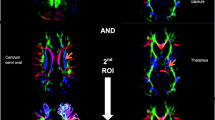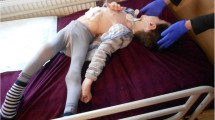Abstract
We report here our studies on the clinical efficacy of courses of magnetophoresis of glutamic acid and magnesium sulfate in the complex rehabilitation treatment of preschool children with spastic types of cerebral palsy. Clinical-neurophysiological investigations were performed in 40 children aged 1–7 years. Treatment was significantly more effective when use of running pulsed magnetic fields was combined with medicinal agents as compared with magnetotherapy using the same regime.
Similar content being viewed by others
References
Yu. I. Barashnev, “Principles of rehabilitation therapy of perinatal damage to the nervous system in neonates and children in the first year of life,” Ros. Vestn. Perinatol. Pediat., 1, 7–13 (1999).
A. M. Vein et al., Lech. Nerv. Bolezn., 2, 10–13 (2003).
O. A. Gromova and A. A. Nikonov, “The importance of magnesium in the pathogenesis of nervous system diseases,” Zh. Nevrol. Psikhiat., 12, 62–67 (2002).
G. A. Drozd, Pediatric Cerebral Palsy: New Conceptual Approaches to Pathogenesis and the Potential of Phytotherapeutic and Social Rehabilitation [in Russian] (2004), http://dr-drozd.narod.ru.
V. A. Dubynin et al., Regulatory Systems in the Human Body [in Russian], Dofa, Moscow (2003), pp. 160–167.
G. Sh. Ishmukhamediv, L. G. Tsypina, and A. Kh. Stoyanova, “Variable magnetic fields in the treatment of pediatric cerebral palsy,” in: Current Problems in the Sanatorium-Spa Treatment of Children: Collection of Studies of the Institute, Evpatoriya, 2, 84–85 (1995).
A. L. Kurenkov, “The role of segmental lesions in the formation of motor disorders in patients with pediatric cerebral palsy,” Zh. Nevrol. Psikhiat., 2, 216–220 (2004).
A. V. Pchelyakov, “Pathomorphology of tissues in the lower limbs in spastic cerebral paralysis”, Ortoped. Travmatol. Protez, 2, 132–133 (2000).
N. I. Strelkova, Physical Methods of Treatment in Neurology [in Russian], Moscow (1983).
N. G. Lenn, “Plasticity and responses of the immature nervous system to injury,” Semin. Perinatol., 11, No. 2, 117–132 (1987).
M. J. Levene, D. Tudehope, and J. Thearle, “Essentials of neonatal medicine, (1987).
J. N. Sanes and J. P. Donoghue, “Plasticity and primary motor cortex,” Ann. Rev. Neurosci., 23, 393–415 (2000).
Author information
Authors and Affiliations
Additional information
__________
Translated from Zhurnal Nevrologii i Psikhiatrii imeni S. S. Korsakova, Vol. 107, No. 12, pp. 45–49, December, 2007
Rights and permissions
About this article
Cite this article
Gurova, N.Y., Babina, L.M. Use of magnetophoresis of glutamic acid and magnesium sulfate in the rehabilitation of children with cerebral palsy. Neurosci Behav Physi 38, 947–951 (2008). https://doi.org/10.1007/s11055-008-9075-5
Published:
Issue Date:
DOI: https://doi.org/10.1007/s11055-008-9075-5




